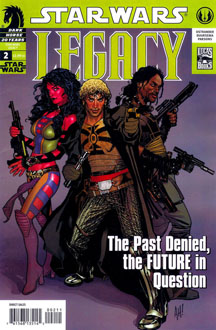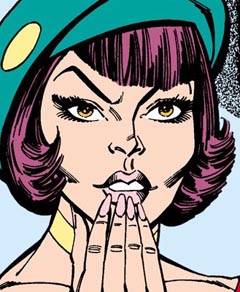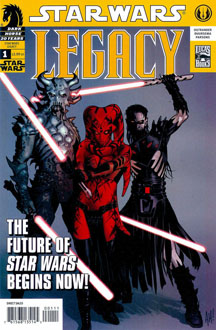Most “Star Wars” stories firmly connect to an established part of the saga, but there are some exceptions in the Legends canon where the author(s) had unusually free reign: Tom Veitch’s “Tales of the Jedi” comics (1993) opened up the galaxy 4,000 years before “A New Hope,” Tim Lebbon’s and John Ostrander’s “Dawn of the Jedi” novel and comics (2013) lifted the veil on the galaxy 25,000 years before “A New Hope,” and Ostrander’s “Legacy” (2006) explored the galaxy 129 years after “A New Hope” (or 125 years after “Return of the Jedi,” as it says on the cover of the first TPB).
Ostrander had proven himself as an outstanding character writer of Quinlan Vos and Aayla Secura in “Republic,” but world-building is a whole ‘nother challenge. In Issues 1-10 of “Legacy” (2006-07), he’s up to the task, although he plays it safe: This era is recognizably “Star Wars,” but on a fresh game board. It’s the comic-writing equivalent of playing with action figures. While I found the similarity between “Dawn of the Jedi” and movie-era “Star Wars” disappointing, I don’t mind it on “Legacy.” After all, these events are only a century after the Yuuzhan Vong war.

Despite “Legacy” carving out a new era, I can’t resist trying to connect it back to the novels storyline that ends with “Crucible,” set 84 years before “Legacy.” And Ostrander can’t resist, either. He suggests in the opening arc, “Broken” (Issues 1-3, 5-7), that the masked Sith Emperor, Krayt, has lived for a long time. When Krayt visits the Sith spirits on Korriban, Darth Aneddu’s ghost mocks him: “The heretic comes for the same reason it came last time. Its body is failing. It fears that which is consuming it.”
Even more intriguing, on the last page of Issue 7, Krayt – who is now thinking of trying to turn Cade Skywalker to the dark side – tells his lackey, Darth Talon:
“I often wonder if I shouldn’t have ended the Skywalker lineage when I had the chance. Perhaps it was fated that I did not.”
A back-of-the-napkin calculation reveals that there’s probably only one unknown generation in the Skywalker family tree. If Ben Skywalker and Vestara Khai had a son when they were about 30, and then that person had a son when he was about 30, that son would be Kol Skywalker, the father of “Legacy” main character Cade. As such, Ben is Cade’s great-grandfather and Luke (whose Force ghost chides the deathstick-smoking Cade) is Cade’s great-great grandfather. Ben could have possibly been alive at the time of Cade’s birth.
“Legacy’s” political setup is a hodgepodge of familiar tropes:
- The Sith Empire, led by Emperor Darth Krayt, holds the most power, including control of Coruscant. Krayt’s acolytes include a bevy of Sith, most of whom sport Darth Maul-style tattoos, most strikingly his “hand,” the Twi’lek Darth Talon.
- The non-Sith Empire is led by Emperor Roan Fel, who has been deposed from the Coruscant throne, but still has a lot of loyal officers, stormtroopers and Force-using Imperial Knights. Fel’s Empire is headquartered on Bastion. Fel’s Empire could potentially join forces with Jedi and/or the Galactic Alliance Remnant against the Sith, but those groups don’t trust it due to its past alliance with the Sith.
- In the wake of the Sith’s victory at the Jedi Temple on Ossus when Cade is a pre-teen (and when Cade’s dad, Kol, is killed), the Jedi are on the run or in hiding.
- Cade, who has rejected his Jedi legacy despite (and because of) his ability to bring dying people back to full health, is a bounty hunter whose team includes his Zeltron girlfriend/mechanic Deliah Blue and his sort-of-friend/pilot Jariah Syn.
- The Galactic Alliance Remnant is small but proud. General Gar Stazi, a Duros, is its most prominent figure.
In “Allies” (Issue 8), Ostrander provides a vague explanation of how the “Legacy” galaxy came to its current political morass.

Emperor Roan Fel: “The Jedi believed the (Yuuzhan Vong) could be habituated … but their efforts were sabotaged. (Imperial Admiral) Veed and many of the high moffs screamed it was an act of war. The Empire issued an ultimatum which the Galactic Alliance – with the Jedi urging – rejected. So we are at war. The Yuuzhan Vong were framed – just as the Jedi claimed. The Sith, who just happened to show up a year into the war as our allies, were the ones who did it.”
In a nutshell, the Sith — led by Krayt — manipulated the political structure in a way that would’ve made Palpatine proud.
The most confusing aspect of “Legacy’s” structure is the question of how Imperial officers and troopers decide whether to serve Krayt or Fel. They must ask themselves if they serve the throne (Krayt) or the man (Fel), and there are cases to be made on both sides. As such, “Noob” (Issue 4) is a crucial issue because Ostrander shows how impossible this decision is for the average stormtrooper, and how absurd it is that they are at war with their fellow stormtroopers.
Another intriguing question of loyalty comes up in “Trust Issues” (9-10) when we meet Imperial agent Morrigan Corde, who also happens to be Cade’s mom, who left Kol and Cade when the latter was a baby. Artist Colin Wilson draws Corde as quite young-looking even though she should be at least in her 40s at this point (although in the “Star Wars” galaxy, humans do tend to age more slowly than on modern Earth).
The most disappointing aspect of “Legacy” – as compared to Ostrander’s “Republic” work – is that Jan Duursema (who co-wrote the “Broken” arc) does not draw every issue. She gorgeously draws “Broken,” but then hands off the reins to a variety of other artists. While she will return for a several future “Legacy” issues, the lack of visual continuity on the title is unfortunate.
Still, the storytelling all comes from Ostrander, and it’s clear through 10 issues that he’s taking the world-building seriously, and he has already created a bevy of complicated interpersonal relationships for Cade. While the backward-looking continuity is undeniably intriguing for continuity buffs, there’s also enough forward momentum that I’m hooked.

